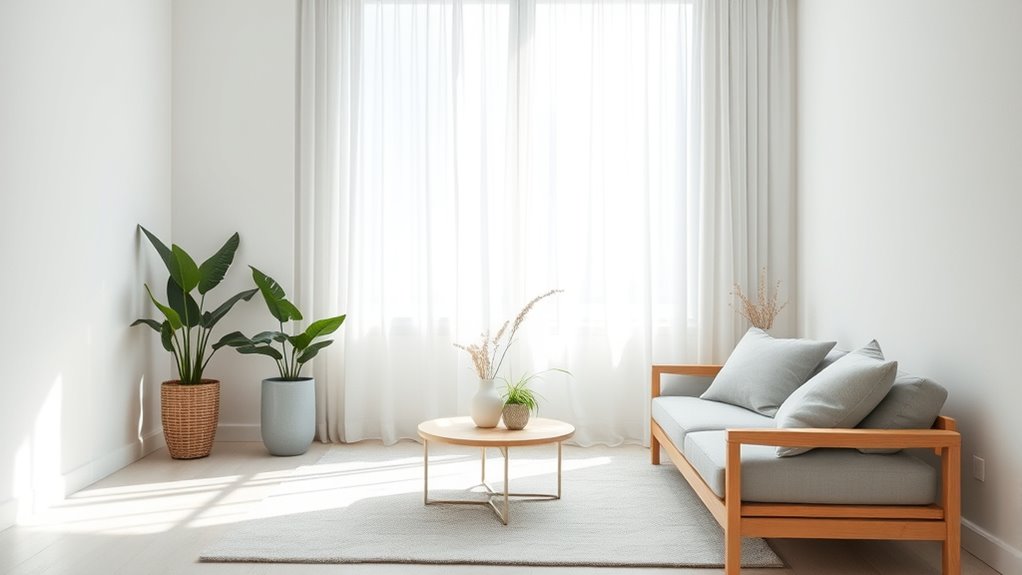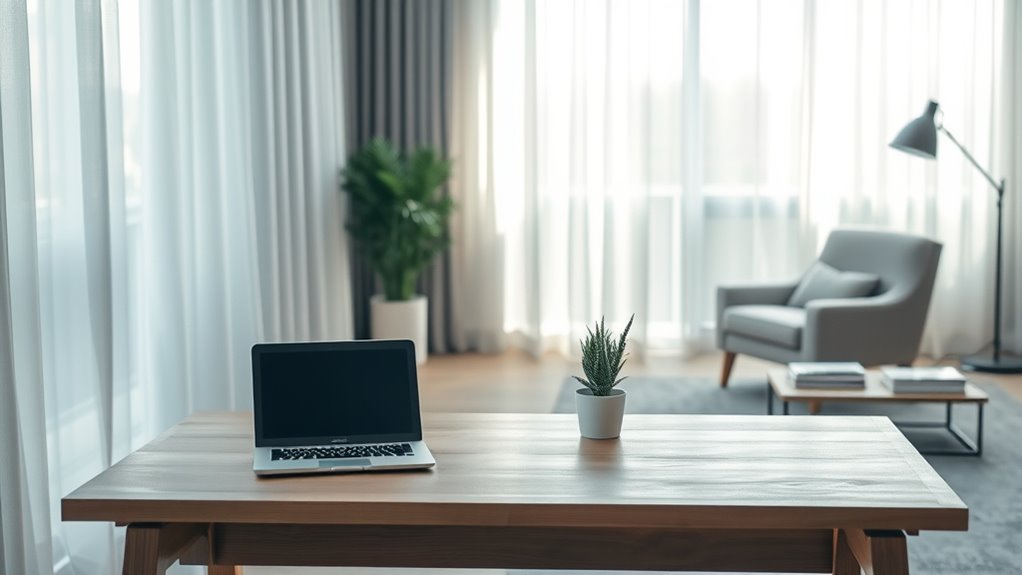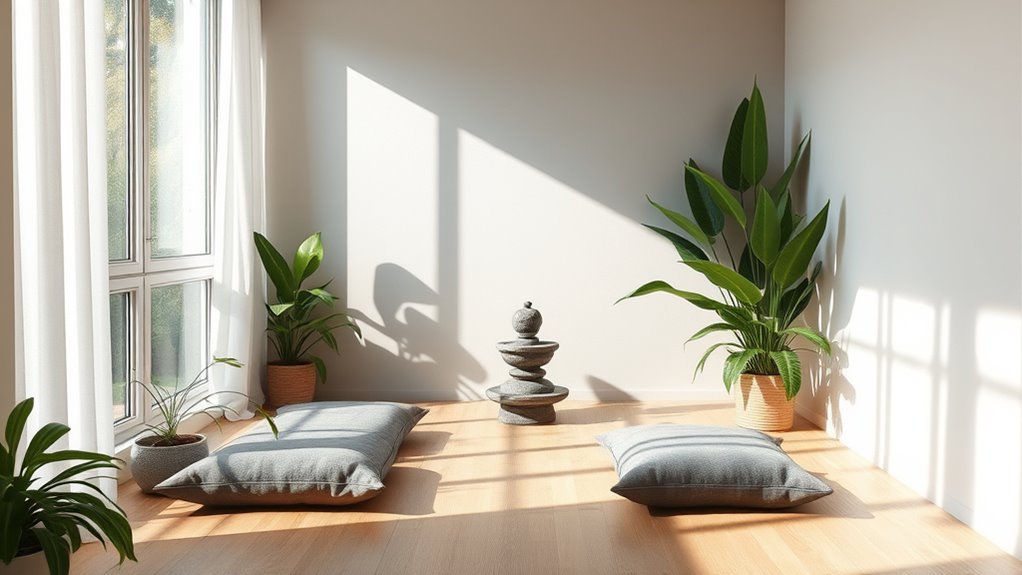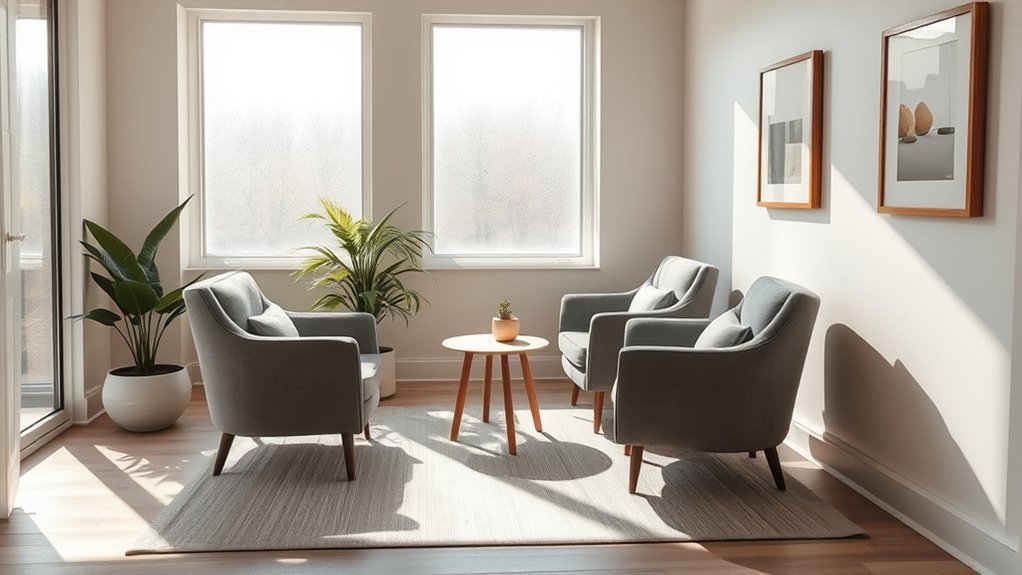To design quiet zones for mental clarity, focus on reducing noise with soundproofing techniques, acoustic zoning, and sound masking. Integrate natural light, calming colors, and natural materials like wood and greenery to foster relaxation. Prioritize secluded locations with privacy and accessible layouts for everyone. Use technology wisely to limit distractions and incorporate biophilic design elements. Regularly maintain the space to guarantee ongoing effectiveness. Keep exploring to discover how these strategies create truly serene environments.
Key Takeaways
- Incorporate soundproofing materials and acoustic barriers to block external noise and minimize distractions.
- Use natural lighting, calming colors, and clutter-free layouts to promote relaxation and mental clarity.
- Design secluded, accessible spaces with privacy features and environmental psychology principles to foster tranquility.
- Integrate natural elements like plants and water features to enhance serenity and reduce stress.
- Balance technology use by limiting digital distractions and promoting device-free zones for focused relaxation.
Understanding the Benefits of Quiet Spaces

Quiet spaces offer more than just a break from noise; they provide essential benefits for your mental and physical well-being. When designed with sound masking, these areas effectively reduce distractions, helping you focus and relax. Acoustic zoning plays a key role by creating designated zones that minimize sound transfer, ensuring peace in busy environments. These strategies help lower stress levels, improve concentration, and boost overall productivity. Quiet zones foster a sense of calm, making it easier to unwind and recharge. Whether in workplaces, libraries, or hospitals, incorporating sound masking and acoustic zoning creates an environment where your mind can breathe. Recognizing these benefits encourages intentional design, turning quiet spaces into crucial retreats for your health and clarity. Additionally, understanding the importance of soundproofing techniques can enhance the effectiveness of these quiet zones.
Key Elements in Designing a Tranquil Environment

Creating a tranquil environment starts with incorporating natural light, which brightens the space and promotes relaxation. Keeping your area clutter-free helps reduce stress and encourages a sense of calm. Paying attention to these key elements makes your quiet zone more inviting and effective. Additionally, integrating biophilic design elements, such as plants and natural materials, can significantly enhance the feeling of serenity.
Natural Light Integration
Incorporating natural light into a space considerably enhances its sense of tranquility, making it feel open and inviting. When you maximize natural light, you create a calming environment that reduces stress and improves focus. Use large windows or skylights to bring in ample daylight, and consider daylight harvesting techniques to optimize light levels throughout the day. These systems adjust artificial lighting based on the amount of natural light available, ensuring consistent brightness without glare or harsh shadows. By thoughtfully integrating natural light, you not only boost the visual appeal but also support your well-being. Proper daylight exposure can improve mood, increase alertness, and foster a peaceful atmosphere—key ingredients for designing a tranquil, quiet zone. Additionally, selecting appropriate window treatments can help control glare and maintain a balanced light environment, further enhancing comfort and clarity.
Clutter-Free Spaces
Clutter can quickly disrupt the sense of calm in a space, making it feel chaotic and overwhelming. To create a tranquil environment, focus on maintaining clutter-free spaces. Use soundproofing techniques like heavy curtains or acoustic panels to minimize noise distractions that can add to chaos. Carefully plan your furniture arrangement to promote openness and flow, avoiding overcrowding. Keep surfaces clear and organize belongings in storage solutions that blend seamlessly with your decor. Incorporate minimal decor to prevent visual clutter, which can increase mental stress. Regularly declutter to keep your space serene and inviting. A tidy, well-organized environment reduces distractions and fosters mental clarity, helping you feel more relaxed and centered in your quiet zone. Additionally, security measures can help protect your space from intrusions, ensuring your environment remains a peaceful retreat.
Selecting the Ideal Location for Quiet Zones

Choosing the right location is essential when establishing a quiet zone, as it directly impacts its effectiveness and accessibility. You want a spot that minimizes urban noise, so it remains peaceful and conducive to mental clarity. Avoid areas with high foot traffic or frequent disturbances, which can undermine the zone’s purpose. Privacy concerns are also critical; select a location that offers seclusion without feeling isolated. Look for corners or tucked-away spaces that naturally shield noise and provide a sense of retreat. Consider proximity to your main areas of activity—too far, and it becomes inconvenient; too close, and noise from nearby activities could intrude. The ideal location strikes a balance between tranquility, privacy, and ease of access, ensuring your quiet zone truly serves its calming purpose.
Incorporating Sound Absorption and Noise Reduction Techniques

To effectively create quiet zones, you need to focus on material choices that absorb sound and prevent noise from escaping. Architectural sound barriers can also play a vital role in blocking external noise sources. By combining strategic material selection with well-designed barriers, you can considerably enhance noise reduction efforts. Incorporating cozy textiles such as blankets and throws can further dampen sound reflections within the space, creating a more serene environment.
Material Selection Strategies
Selecting the right materials is essential for effectively reducing noise in quiet zones, as they directly influence sound absorption and insulation. Acoustic panels are a popular choice because they absorb sound waves and minimize echo, creating a calmer environment. When considering fiber optics, think beyond lighting—integrating fiber optic sound diffusers can help disperse sound evenly, reducing sharp noise peaks. Use dense, soft materials like fabric-covered panels or mineral wool for walls and ceilings to enhance sound insulation. Additionally, choosing materials with high noise reduction coefficients (NRC) ensures better performance. Incorporating HEPA filtration principles into material selection can also help improve air quality and reduce airborne noise. Tailoring material selection to the space’s purpose and layout maximizes noise control. This strategic approach results in a quieter, more focused environment that supports mental clarity and well-being.
Architectural Sound Barriers
Architectural sound barriers play a crucial role in controlling noise levels within quiet zones by physically blocking and absorbing sound waves. You can enhance their effectiveness with soundproofing techniques and strategic acoustic paneling. These barriers may feature materials like dense concrete or specially designed wall systems that prevent sound from passing through. Visualize a barrier with layered surfaces, absorbing sound energy and reducing echoes. Incorporating sound absorption methods such as specialized acoustic materials can significantly improve noise reduction performance. – Heavy, textured surfaces that diffuse noise – Vertical screens that shield outdoor spaces – Acoustic panels integrated into walls or fences
Utilizing Color, Lighting, and Materials to Promote Calmness

Colors, lighting, and materials play a crucial role in creating calming environments within quiet zones. Using color psychology, you can select soft, neutral hues like blues, greens, and earth tones that evoke relaxation and reduce stress. Lighting techniques such as diffused, warm lighting help foster a sense of comfort and tranquility, avoiding harsh or flickering lights that may cause agitation. Choose materials with natural textures—wood, fabrics, and smooth surfaces—that promote warmth and a tactile sense of calm. These elements work together to establish a peaceful atmosphere, subtly influencing mood and behavior. By thoughtfully combining colors, lighting, and materials, you create a space that encourages mental clarity and relaxation, making it easier for individuals to unwind and focus. Incorporating environmental psychology principles can further enhance the calming effects of your design.
Designing for Accessibility and Inclusivity

When designing quiet zones, you need to prioritize universal design principles that make spaces accessible for everyone. Incorporating adaptive features guarantees that all users, regardless of ability, can comfortably use the space. By focusing on inclusivity, you create environments that are welcoming and functional for diverse needs. Considering nail styles names can also inspire thoughtful design elements that cater to individual preferences and expressions.
Universal Design Principles
Universal Design Principles emphasize creating environments that are accessible and inclusive for everyone, regardless of ability or background. When designing quiet zones, consider how sensory overload and visual clutter can impact comfort and focus. To promote inclusivity, focus on:
- Simplified layouts that reduce visual clutter, making spaces easier to navigate
- Use of calming colors and textures to prevent sensory overload
- Clear signage and intuitive design to support varied abilities
These principles help ensure your space accommodates diverse needs, fostering mental clarity for all users. Avoid overwhelming sensory input by minimizing unnecessary decorations or bright, busy patterns. Instead, aim for a balance that invites calm and clarity, making your environment welcoming and functional for everyone. Incorporating a variety of textures can also enhance sensory comfort without causing overstimulation. Applying universal design principles creates spaces where everyone feels comfortable and supported.
Adaptive Space Features
Designing for accessibility and inclusivity requires integrating adaptive features that respond to diverse needs. Sound masking helps mask disruptive noises, creating a more inclusive environment for those sensitive to sound. Privacy partitions are essential for providing personal space and reducing distractions, especially for individuals with different privacy requirements. These features allow you to adjust the space according to individual preferences, fostering a sense of comfort and control. Incorporating sound masking and flexible privacy partitions ensures that your quiet zone accommodates a broad range of users, promoting mental clarity for everyone. By focusing on adaptive space features, you create environments that are not only functional but also supportive of varied sensory and privacy needs. This approach encourages inclusivity and reinforces your commitment to a universally accessible space.
Incorporating Nature and Biophilic Elements

Incorporating nature and biophilic elements into quiet zones transforms these spaces into calming refuges that foster relaxation and well-being. By reducing the impact of urban noise, you create an environment where tranquility prevails. Use natural materials, such as wood or stone, to evoke a sense of grounding. Integrate plants and greenery to soften the space and improve air quality. Consider cultural symbolism like traditional motifs or nature-inspired artwork that connects visitors to local heritage. Visualize:
Transform quiet zones with natural elements—soothing greenery, natural materials, and calming water features for peaceful retreats.
- Verdant walls with cascading ivy and lush foliage
- Soft, natural lighting filtering through skylights or windows
- Water features that produce gentle, soothing sounds
These elements promote mental clarity by immersing you in a calming environment, making the space a true escape from external chaos.
Technology and Connectivity Considerations

While integrating natural elements creates a peaceful environment, addressing technology and connectivity guarantees that quiet zones truly support focused relaxation. To enhance this, consider limiting wearable technology that constantly tracks your activity, which can distract from mental clarity. Encourage a digital detox by designating specific times or areas where devices are off-limits, helping you disconnect from notifications and digital noise. You might also incorporate physical signage or subtle cues that remind users to pause their screens. Ensuring strong but unobtrusive Wi-Fi or Bluetooth signals allows for necessary connectivity without overwhelming the space. By balancing technology use with intentional disconnection, you create a sanctuary that fosters genuine relaxation, free from digital interruptions. This approach helps you fully unwind and recharge mentally.
Maintaining and Adapting Quiet Zones Over Time

To guarantee your quiet zones remain effective over time, regular maintenance and thoughtful adaptation are essential. You should routinely evaluate your soundproofing techniques, checking for wear or damage that could compromise sound insulation. Establish maintenance routines like sealing gaps, replacing worn materials, and ensuring doors and windows close tightly. As your environment evolves, adapt the space by adding or upgrading soundproofing elements to address new noise sources. Visualize:
- Inspecting walls and ceilings for cracks or gaps
- Upgrading insulation materials periodically
- Sealing leaks around doors and windows
Case Studies of Effective Quiet Zone Implementations

Examining real-world examples reveals how effective quiet zones can be designed and maintained to achieve ideal soundproofing. In a corporate office, installing acoustic panels along walls and ceilings considerably reduced noise, creating a peaceful environment. They complemented sound masking systems that emitted gentle background noise, masking distracting sounds and enhancing focus. Another example is a library that combined acoustic panels with strategic layout changes, such as separating noisy areas and adding soft furnishings. These measures minimized sound leakage and improved acoustics. By integrating sound masking technology and acoustic panels, these spaces successfully foster mental clarity. These case studies demonstrate that combining physical soundproofing with audio masking creates highly effective quiet zones, suited for concentration, relaxation, and productivity.
Frequently Asked Questions
How Do Quiet Zones Impact Overall Workplace Productivity?
Quiet zones considerably boost your workplace productivity by reducing distractions and fostering focus. With sound masking and acoustic treatment, these areas minimize noise pollution, helping you concentrate better. When you create designated quiet zones, you enable yourself and your team to work more efficiently, make fewer mistakes, and feel less stressed. Ultimately, these spaces promote mental clarity, leading to higher quality work and improved overall performance in your workplace.
What Budget Considerations Are Involved in Creating Tranquil Environments?
When creating tranquil environments, you should consider budget-friendly materials and cost-effective solutions to keep expenses manageable. Focus on prioritizing investments that maximize impact, like soundproof panels or natural elements, without overspending. By carefully planning your budget, you can balance quality and affordability, ensuring the space promotes mental clarity without exceeding financial limits. This approach helps you develop effective, calming spaces that are both functional and budget-conscious.
How Can Quiet Zones Be Integrated Into Urban Public Spaces?
Imagine a sanctuary amid city chaos, where you find calm. To create quiet zones in urban public spaces, you can incorporate soundproof barriers that block noise, while landscape integration blends nature with design. Strategically placing greenery and water features helps dampen sound and invites relaxation. These elements symbolize a retreat within the urban fabric, offering you a peaceful pause, enhancing mental clarity amid bustling city life.
What Are the Best Practices for Maintaining Quiet Zones Long-Term?
To maintain quiet zones long-term, you should regularly evaluate soundproofing techniques, ensuring materials stay effective and undamaged. Implement clear signage strategies to remind visitors of the zone’s purpose and promote respectful behavior. Keep pathways clear and monitor noise levels consistently. Engaging the community helps sustain these spaces, making sure they remain peaceful. Regular maintenance and active oversight are key to preserving the tranquility and effectiveness of your quiet zones over time.
How Do Cultural Differences Influence Quiet Zone Design Preferences?
When it comes to quiet zone design, understanding cultural perceptions is key. You need to recognize that what feels peaceful in one culture might differ in another. By making thoughtful design adaptations, you respect these differences and create environments that promote mental clarity for everyone. Listening to diverse needs ensures your quiet zones are inclusive and effective, because you don’t want to put all your eggs in one basket.
Conclusion
So, next time you crave peace amidst chaos, remember that creating a quiet zone isn’t just about silence—it’s about reclaiming your clarity. Ironically, in a world obsessed with noise and distraction, your best refuge might be the simplest, quietest space you design. Embrace the calm, and you’ll discover that sometimes, the loudest message is the one whispered in silence. After all, peace isn’t found in noise, but in the stillness you create.








